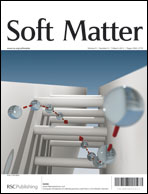Polymerized crystalline colloidal array (PCCA) films, i.e., a highly ordered crystalline colloidal array of poly(N-isopropylacrylamide-co-acrylic acid) (P(NIPAM-AAc)) microgel particles embedded in a polyacrylamide (PAAm) hydrogel matrix, were prepared. The interaction between the embedded thermosensitive microgel particles and the non-thermosensitive hydrogel matrix was studied, using the Bragg diffraction of the films as a tool. The intensity and position of the diffraction peak change with temperature, from which important information on the interaction between the microgel particles and the hydrogel matrix was deduced. Our results indicate that the non-thermosensitive, hydrophilic PAAm hydrogel matrix significantly influences the thermosensitive phase transition of the embedded P(NIPAM-AAc) microgel particles. Compared with the freely dispersed microgel particles in solution, only a small change in the volume phase transition temperature of the embedded microgel particles was observed; however, the phase transition becomes less sharp. More importantly, the extent of size change is reduced significantly. On the other hand, the temperature-induced swelling/deswelling of the embedded microgel particles induces a swelling/deswelling of the surrounding hydrogel matrix, revealing that the interaction between the two components is mutual. The temperature-induced swelling/deswelling of the microgel particles is fast; in contrast, the swelling/deswelling of the hydrogel matrix is much slower. The stiffness of the hydrogel matrix affects the interaction between the two components. As the hydrogel matrix becomes stiffer, its influence on the swelling of the microgel particles becomes more prominent. On the other hand, the influence of the microgel particles on the swelling of the hydrogel matrix becomes less prominent.

You have access to this article
 Please wait while we load your content...
Something went wrong. Try again?
Please wait while we load your content...
Something went wrong. Try again?


 Please wait while we load your content...
Please wait while we load your content...